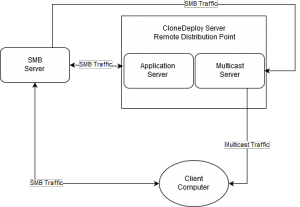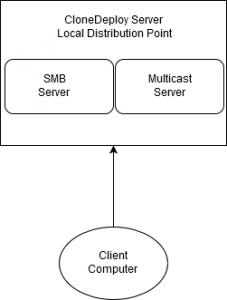I. Alternate Storage Location On Local Server
From the diagram, we can see that this setup is very simple. All traffic from the client computer goes directly to the CloneDeploy Server. The CloneDeploy Server is acting as both the SMB server and the Multicast server.
- Disable the existing share located at program files (x86)\clonedeploy\cd_dp
- Create a new directory at your desired location with a name of your choice. I will use c:\myshare for this example.
- Inside that directory, create two more directories – images and resources
- You should now have a directory structure that includes c:\myshare\images and c:\myshare\resources
- Create a new share at the base c:\myshare directory
- Give the share a name of your choice
- When CloneDeploy was installed 2 local user accounts were created cd_share_ro and cd_share_rw – Add the users to the share permissions, giving cd_share_ro READ access and cd_share_rw CHANGE access. If you want to create your own accounts instead of the pre-installed accounts feel free to do so. If you need to use a domain account be sure to use an account with the least permissions possible, never use an admin account. Update the security(NTFS) permissions to match. cd_share_rw MODIFY and cd_share_ro READ AND EXECUTE
- Next, the CloneDeploy Web Application also needs permission to write to this directory. Add the user IIS_IUSRS to the security permissions of the c:\myshare directory with MODIFY permissions.
- Test your share from another machine using those 2 accounts
- Open the CloneDeploy Web Interface and go to Admin -> Distribution Points
- Select View on the primary distribution point
- Update the following fields to reflect any changes you made, share name, domain, read write username, read write password, read only username, read only password it is possible that none of those fields need changed.
- Update the physical path to your shared directory, in this example it would be c:\myshare
- Click Update Distribution Point
II. Alternate Storage Location On Remote Server
A. Block Level (iSCSI , Fibre Channel)
Not much to this one, just mount the block device to your CloneDeploy server and follow the previous guide for Alternate Storage On Local Server. In this scenario CloneDeploy will still remain as the SMB server for your clients.
B. File Level (SMB)
 From this diagram we can see that setting up a Remote Distribution Point changes the behavior of the Client Computer. The Client Computer now connects directly to the remote SMB server, bypassing the CloneDeploy server. However, multicasts still connect to the CloneDeploy server. The multicast server grabs the image from the remote SMB server and sends it to the client through the CloneDeploy server. Also, the CloneDeploy Application Server connects directly to the remote SMB Share.
From this diagram we can see that setting up a Remote Distribution Point changes the behavior of the Client Computer. The Client Computer now connects directly to the remote SMB server, bypassing the CloneDeploy server. However, multicasts still connect to the CloneDeploy server. The multicast server grabs the image from the remote SMB server and sends it to the client through the CloneDeploy server. Also, the CloneDeploy Application Server connects directly to the remote SMB Share.
I cannot give exact instructions on how on how to setup the remote share since they are so many different devices that can provide SMB services. Here is a generalization.
- Create a new SMB share on your remote NAS, SAN, File Server, etc.
- There should be two levels of access, a read only user and a read write user – this can sometimes be complicated, if you cannot achieve this, a single read write user will work but isn’t recommended
- The share must have two sub directories – images and resources
- Open the CloneDeploy Web Interface and go to Admin -> Distribution Points
- Select View on the primary distribution point or create a new one, don’t forget to make it primary
- Update all fields to match the settings for your SMB share
- Set the Location to Remote
- Click Update Distribution Point
